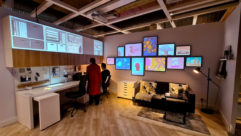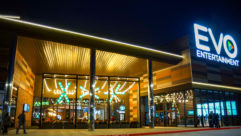

What Does a Digital Signage Setup Really Cost?
One of the most difficult things to do is determining how much something will cost when it’s beyond one’s knowledge base. I’m sure every integrator reading this has been asked by a client to produce a budget estimate for a project where, in many cases, the client probably had no idea what to expect. When it comes to digital signage solutions especially, that’s more often the case than not.
One of the most difficult things to do is determining how much something will cost when it’s beyond one’s knowledge base. I’m sure every integrator reading this has been asked by a client to produce a budget estimate for a project where, in many cases, the client probably had no idea what to expect. When it comes to digital signage solutions especially, that’s more often the case than not.
There are so many different components to digital signage it can be difficult for you and your client to get your head around the total cost. So I thought I’d break down a couple scenarios to help your clients in their budgeting processes.
Remember, no two digital signage solutions will be the same–ever. This is one AV discipline that cannot be boiler-plated. Yes, some elements will be shared among solutions; others are complete variables.
Use this information as a guide, keeping in mind you’ll want to vary some of it based on your specific buying abilities and expected profit margins.
A Higher Ed Signage Solution
First, let’s look at a higher education scenario. In this case, the client wants to start small and add to the system as department heads become interested. He has plans to start with three locations–the cafeteria, the registrar’s waiting area, and Main Hall (the largest of the classroom buildings). He doesn’t know yet what information will appear on the displays, and their exact locations have only been discussed, not defined.
The plan is to have three or four large flat-panel displays in the cafeteria, one at registration, and one on each floor of the three-story Main Hall. He says the IT department will support the hardware after it’s installed, but he doesn’t know who will be producing content. In the end, it’s likely a number of different people will be using the system to input their information.
Step 1: Break It Down. From the information gleaned, we see we’ll need a maximum of eight displays. We don’t know where they will go, so we’ll have to assume the most expensive mounting and installation. The IT department’s involvement gives us the impression they’re open to a hardware/software solution, so we’ll assume we will be providing the player PCs and the server as part of the system. And it’s clear from the usage model they’ll need a signage application that supports decentralized content creation by various content owners.
Step 2: Flesh It Out. Let’s not waste a lot of time in this step–we’re not fully engineering a solution and the client should be made aware of that. For budgeting, we just need to describe a general system that will support the objectives. For the eight displays, let’s choose 40-inch LCDs. Go with eight PCs to act as content players because we don’t know what content will be shared and therefore have to assume the most flexible solution. (In reality there would probably be three players, one for each building with signal distribution to get the output to the displays.) Finally, account for one server, all necessary mounts (we’ll have to come in high here to cover potentially expensive ceiling-mount possibilities), and the software solution.
For our purposes, we’ll assume the computers (PC players and server) will be part of the signage system, but that’s not always the case, depending on your choice of solutions. But keep one thing in mind: The client said he wants a scalable solution, so plan for expansion by providing the right platform and components.
Step 3: Mix in Some Numbers. When we add it up in our higher education scenario, we get:
- Displays $13,000–$18,000
- Mounts $3,500
- Computers $10,000–$12,500
- Software $15,000–$20,000
- Labor/PM/Misc $6,000
In the end, this scenario yields a budget of between $47,500 and $60,000, or roughly $6,000 to $7,500 per display.
A Corporate Signage Solution
Now let’s look at a corporate scenario. For this project, the client would like to deploy a campuswide employee information system. He plans to deploy it in four locations: the headquarters building, the assembly plant down the road, and two sales offices, each about 30 miles from HQ. He doesn’t know yet what information will be on the displays.
The plan is to have four large flat-panels in the main building, two at the plant, and one at each branch office–all wall mounted. IT has said it will provide a network connection for each location, but due to budget constraints, it will not be able to support the initiative beyond that. The client’s team will handle content. He also indicates there isn’t a lot of money available for the system itself, but there is money in the budget for running the system.
Step 1: Break It Down. Based on the client’s account, we’ll need eight displays, which will be wall mounted. Lack of IT involvement and a limited budget indicate a Software-as-a-Service (SaaS) application model would probably work best.
Step 2: Flesh It Out. Recall, money for the system (a capital expenditure) is limited, but money for running the system is available (perfect for SaaS).
We’ll need eight displays (40-inch LCDs), eight PCs (again, because we don’t know what content will be shared, we have to assume the most), mounts, and the SaaS hosted software solution. It’s possible the PCs will be part of the SaaS solution, but not necessarily–that’s your decision based on the choice of solution.
Step 3: Mix in Some Numbers. In coming up with a budget estimate for our corporate client, we get:
- Displays $13,000–$18,000
- Mounts $2,500
- Computers $10,000
- Software $6,500 per year
- Labor/PM/Misc $6,000
This scenario yields a budget of between $38,000 and $43,000, or roughly $5,000 per display for the first year. Each year thereafter, the cost would be $6,500.
As you can see, the two scenarios are similar in project scope, but different from a budget perspective based on the way we evaluated the information. Granted, none of the soft costs have been addressed, such as full- or part-time hires. Those costs are difficult for you to quantify, being an outsider. Still, be prepared to discuss the client’s internal needs regarding content creation and system administration.
Also, these scenarios have been simplified to provide rules of thumb you can use to help your clients with budgeting. By doing similar exercises with your signage offerings, you’ll be able to intelligently communicate a picture of a solution your client can understand–and hopefully get onboard with.
Kris Vollrath is vice president of Advanced AV in West Chester, Pa., an industry consultant, and frequent speaker on digital signage applications and technology.










